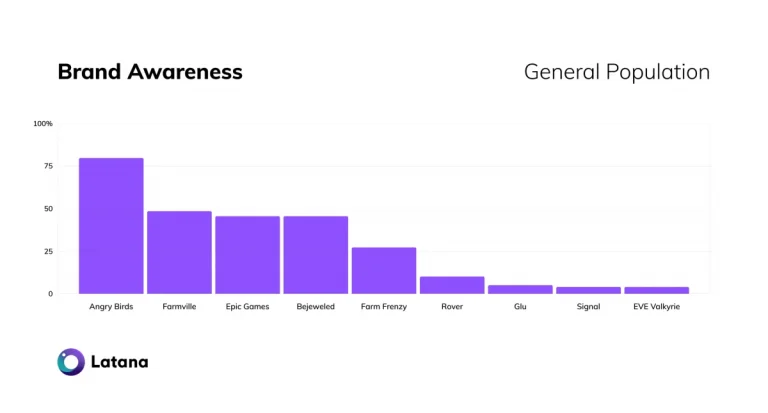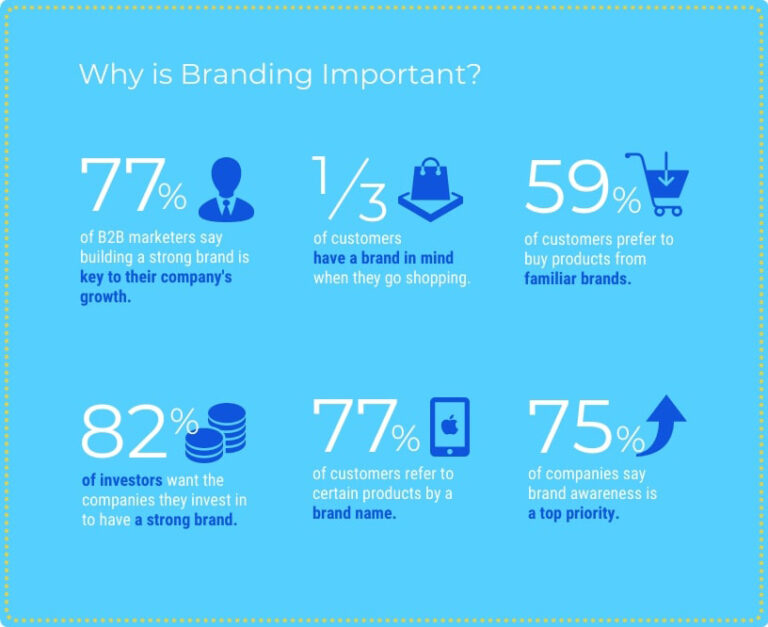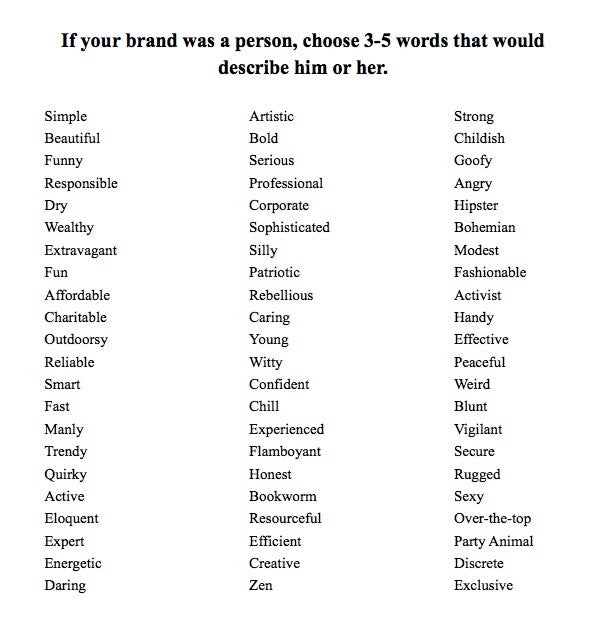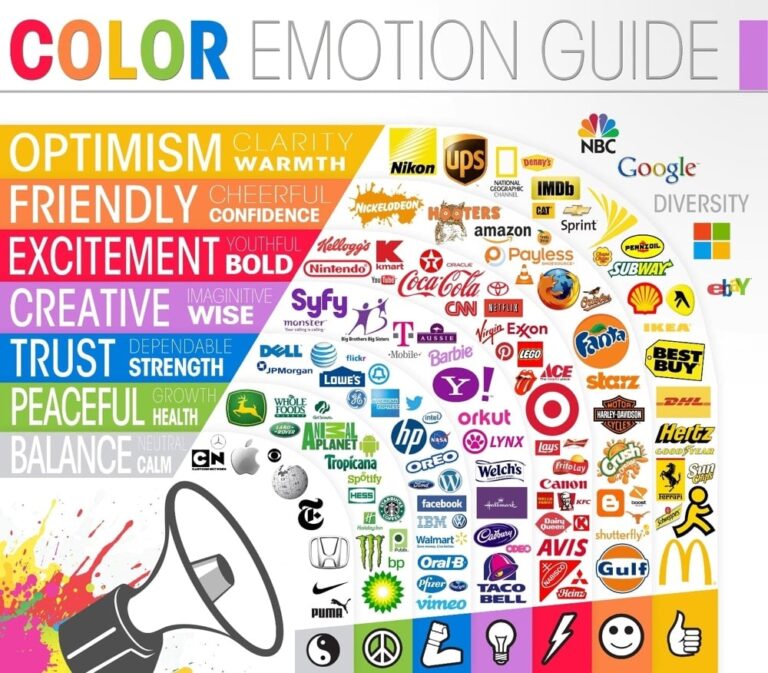Regardless of the industry, a great brand identity is extremely important in today’s competitive business world. More than ever, if you want to attract and engage with your audience, you need to differentiate from your competition and stand out of the crowd.
Which are the first words that come up in your mind when thinking about Coca-Cola, Nike, Apple, or Cadbury? Exactly, a strong and consistent brand image. For example, Coca-Cola is associated with fun and enjoyment, Nike with sport and innovation, Cadbury is synonymous with happiness, while Apple emphasizes technological research and advancement.
In the mobile gaming world, Angry Birds has the highest level of brand awareness among the general population (79%), being followed by FarmVille (48%), Epic Games (45%), Bejeweled (45%), and Farm Frenzy (27%). They make the top five most known games.

These games are famous for their entertaining and great animations and their popularity allowed their creators to sell beyond the games, tap into the merchandise market, and even create movie deals. So, when you design and implement a consistent brand identity for your game, you can also succeed in the local and international markets.
However, having a strong brand will not happen overnight. You can’t expect that right after setting your brand colors, designing your logo, and writing your slogan to gain that special position in your gaming community’s mind.
You need much more to develop a reputable brand image, and here are the most important steps to consider. But let’s start with the most important part:
What is brand identity?
It is the collection of all elements you create to illustrate a specific image in the eyes of your audience. It differs from branding and brand image even if all these terms are many times considered interchangeable.
Branding includes all the actions you take to shape your brand and help people quickly identify and connect with your business. By clarifying what your brand is and isn’t, you position yourself in a specific way in your audience’s mind and give them reasons to choose your products and/or services over the competition’s.
The difference between brand image and brand identity lies in perspective. Brand image is the customers’ perception of your brand, based on their interactions – from reading your website’s blog post or landing page to speaking with a community manager on Facebook. On the other side, brand identity is controlled by you.
In the past, brand identity referred just to the visual elements of your brand – from logo and brand colors to presentations, brochures, and advertisements. But in the digital age, it is the personality that defines your brand in your customer’s eyes. It includes your brand values, visual design, and voice, unique selling point, and how your brand interacts with customers.

Why do you need a brand identity for your game?
A few things are mandatory when you interact with your audience but having a strong brand identity is a must-have and comes with many benefits.
According to a 2021 branding report, 75% of marketers say brand awareness is a top priority for their companies because:
- 1/3 of customers have a brand in their mind when going to shopping
- 59% of customers prefer to buy from a familiar brand
- 54% of the businesses state that brand consistency substantially contributes to their business growth

Also, Apple, Nike, and Nintendo are the top 3 brands Americans love. What do all three have in common? Right, strong brand identities!
Some other benefits are:
1. Gives your business a face

Do you remember that people are always talking about making the “first impression”? Well, the same happens with brands: when a new customer interacts for the first time with your game, he has seven seconds or less to make an opinion. And here is where your brand identity comes in: it gives your game (and business) a “face”.
When done right, your players can recognize your game just when seeing only some key parts of your branding. Check below some iconic brands.
2. Helps build trust and credibility
A strong and consistent brand identity doesn’t just make your brand recognizable, but it also helps build trust with your customers. Like human-to-human relationships, building brand-to-customer relationships takes time and involves many aspects.
However, it is also important to deliver what you promised, because your customers will make assumptions about the perceived value of your product starting from what your visual identity and voice look like.

3. Brand identity increases connection with your customers
Even if you might not believe it, the values of your business matter to your customers. While your brand’s values may drive your marketing strategy, plan, and actions, it’s also extremely important for your customers when shopping. According to a recent study of over 1,000 millennial-age customers, 83% of consumers prefer to buy from brands that share the same values.
The values included in your brand identity set you apart from the competition and impose it as a unique brand. They give customers an emotional and tangible reason to engage with your business and drive your sales.
How to create your brand identity
Finding a brand identity that is unique and authentic is not simple or easy. In this section we’ll give you the exact step by step process for creating a strong brand identity that passes the exam of time:
1. Do your research
Before making any decision related to your brand identity, do your homework. Research and understand the market you act on, identify your main competitors, and identify your target audience.
There are many ways for making your research, some examples of best practices being:
- Google your game category and analyze the direct and indirect competitors that come up
- Interact with people who are part of your target market and ask them what game brand they play/downloaded/bought in your niche
- Check the relevant social media accounts and pages your audience follows and interact with
When making your research, also make notes about:
- your potential main target – the ones who would be the most likely to play/download/buy your game
- who your top-of-mind competitors are –brands that are established and well known on the market
- how your potential players speak and what they talk about – the main interests and hobbies they have and the language they use to express them
It’s important to know as much information as you can before moving forward, as it will inform what your brand should focus on and how it can position itself apart from competitors.
2. Build your initial brand identity
The best brand identities follow the “DECMS” principles, as they are:
- Distinct
- Easy to apply
- Cohesive
- Memorable, and
- Scalable as your brand grows.
Even if each brand identity is unique, following the DECMS criteria requires creating two key elements: your mission and your brand personality.
And when deciding about those two, remember that you can’t establish your brand to be everything for everyone. Or at least, not from the beginning.
So, what’s your mission?
Your mission is one or two lines that stake your claim in the market. This isn’t necessarily something you put on your website or social media, but it acts as your internal guidelines and helps you answer the right questions about your brand and aids in creating your brand’s tagline.

Your unique value proposition is the one thing you’re competing on. Find it, go in on it, and make it a part of your brand’s messaging.
3. Find the words you would associate with your brand
When designing your brand identity, try to imagine your brand as a person. What would he or she look like? What kind of personality would your customers be attracted to? This step will help to set your voice tone for all your creatives, both visual and written. A fun and useful exercise for how to create a new brand is pitching three to five adjectives that describe the type of brand that might resonate with your audience. I compiled this list of traits to help you get started.

4. Choose the look of your brand
Once you’ve set your game’s name and its personality, it is time to think about your brand design—how you’ll visually represent your brand – meaning your colors, logo, and typography.
Choosing your colors
Colors are important not just for the way your brand looks like, but they also convey the feeling you want to communicate and help you make it consistent across everything you do. You’ll want to choose the right colors for your brand, aiming to differentiate you from direct competitors and avoid confusion.
Color psychology is not an exact science, but it acts as a guideline and helps you to make the right decisions, especially when it comes to the color you pick for your brand logo.
This infographic offers an overview of the emotions and associations that different colors generally evoke:

In addition, try to make all the possible combinations: white and black text over the colored logo, and colored text over the black and white backgrounds. A tool like Coolors might help you to identify the best color scheme for your brand.
Choosing your fonts
Fonts are part of your brand image and together with your brand colors convey your brand message. And the best way of using fonts is to keep it simple. Excepting the font used for logo (if you prefer this option), limit your choosing a maximum of two fonts to avoid confusing your audience: one for headings and one for body text.
An efficient tool can be Font Pair which gives you access to a wide selection of fonts that go well together.

5. Design your logo
When thinking about building your brand, probably designing your logo is the first thing that comes into your mind. And this is for good reason: it’s the face of your company and can be all over where your brand exists.
Ideally, you’ll want a logo that is identifiable, unique, and scalable, so you could use it in all sizes (something often overlooked). A rule of thumb is to consider all the potential places where you might post your logo: starting with business cards, website, social media, and even the little “favicons” you see in your current browser tab.
If you have a text logo as your Instagram avatar, for example, it’ll be almost impossible to read. To make your life easier, create a square version of your brand logo with an icon element that remains recognizable even in smaller sizes.
6. Apply your new brand identity across your business
Applying your branding across your business gives it a cohesive brand story. It reflects who your business is and what it stands for. It sets the stage for every interaction your brand will have with your players, in-store and online.
Wrapping UP
A brand image is a big thing to work on, and it can make or break your brand. Without the right game marketing strategies (along with efficient development and localization strategy), it will be challenging to become a well-known brand in the competitive gaming industry. Your download stats will remain low, and you will struggle to generate revenue from product sales. The members of SandVox team are experts in helping you set yourself up for success and stay on track into the future.
Need more info? Let’s chat today about how we can make the most of your gaming opportunities.






